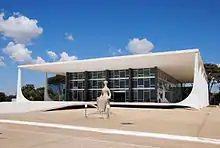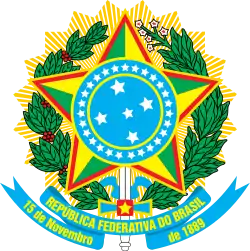Supreme Federal Court
The Supreme Federal Court (Portuguese: Supremo Tribunal Federal, [suˈpɾẽmu tɾibuˈnaw fedeˈɾaw], abbreviated STF) is the supreme court (court of last resort) of Brazil, serving primarily as the Constitutional Court of the country. It is the highest court of law in Brazil for constitutional issues and its rulings cannot be appealed. On questions involving exclusively non-constitutional issues, regarding federal laws, the highest court is, by rule, the Superior Court of Justice.
| Supreme Federal Court | |
|---|---|
| Supremo Tribunal Federal | |
 The Supreme Federal Court building at the Praça dos Três Poderes (Three Powers Plaza) | |
 | |
| Established | 1808 |
| Location | Brasília |
| Composition method | Presidential nomination with Senate confirmation |
| Authorized by | Constitution of Brazil |
| Judge term length | Until aged 75 |
| Number of positions | 11 |
| Website | Official website |
| President | |
| Currently | Luiz Fux |
| Since | September 10, 2020 |
 |
|---|
| This article is part of a series on the politics and government of Brazil |
|
|
History
The court was inaugurated during the colonial era in 1808, the year that the royal family of Portugal (the House of Braganza) arrived in Rio de Janeiro. It was originally called the House of Appeals of Brazil (Casa de Suplicação do Brasil).
The proclamation of the Brazilian Declaration of Independence and the adoption of the Imperial Constitution in 1824 preceded the establishment of the Supreme Court of Justice (Supremo Tribunal de Justiça) in 1829. With the first Constitution of the Republic, the current Court was established.
Although the constitutional norms that regulated the creation of the Court allowed Deodoro da Fonseca, Brazil's first president, to nominate an entirely new Court, the president chose to nominate as the first members of the Supreme Federal Court the ministers who were then serving as members of the predecessor imperial Court.
Two hundred members have served on the Court. The Constitution of 1891 decided that the Court would have 15 members. When Getúlio Vargas came into power, the number of members was reduced to 11. The number was changed to 16 in 1965, but returned to 11 in 1969 and has not changed since. Of all Presidents of Brazil, only one (Café Filho) never nominated a minister.

All judicial and administrative meetings of the Supreme Court have been broadcast live on television since 2002. The Court is open for the public to watch the meetings.
Functions
Alongside its appeal competence, mostly by the Extraordinary Appeal (Recurso Extraordinário), the Court has a small range of cases of original jurisdiction, including the power of judicial review, judging the constitutionality of laws passed by the National Congress, through a Direct Action of Unconstitutionality (Ação Direta de Inconstitucionalidade, or ADI). There are also other mechanisms for reaching the Court directly, such as the Declaratory Action of Constitutionality (Ação Declaratória de Constitucionalidade, or ADC) and the Direct Action of Unconstitutionality by Omission (Ação Direta de Inconstitucionalidade por Omissão or ADO).
Case law
In May 2009 The Economist called the Supreme Federal Court "the most overburdened court in the world, thanks to a plethora of rights and privileges entrenched in the country's 1988 constitution (...) till recently the tribunal's decisions did not bind lower courts. The result was a court that is overstretched to the point of mutiny. The Supreme Court received 100,781 cases last year."[1]
Overruling seems to be frequent in SFC jurisprudence: "three years ago when the STF adopted the understanding that defendants who have a conviction upheld by a single appellate court may be sent to jail to begin serving their sentences. (...) The 2016 decision happened largely due to a change in opinion from Justice Gilmar Mendes (...). He had voted against sending defendants to jail after a single failed appeal in 2009, but changed his mind in 2016. Jump to 2019, and the circumstances – both political and judicial – have changed".[2]
President of the Court
The President and Vice-president of the Court are elected by their peers for a term of two years by secret ballot. The currently serving President is Luiz Fux.
Re-election for a consecutive term is not allowed. By tradition, the members of the Court always elect as president the most senior minister of the Court that has not yet served as President, to avoid politicization of the Court.
If all members currently sitting on the Court have already served as president, the rotation starts all over again; however, due to the existence of a compulsory retirement age, and the consequent appointment of new ministers to fill those vacancies, it is very rare for the cycle to be completed and restarted, and some ministers are forced to retire before their turn in the presidency arrives, as was expected to happen with Teori Zavascki.
According to the same convention, the Court selects as vice-president for a certain term the minister who, according to that tradition, will be selected president in the succeeding term. Also by tradition, the elections of the president and vice-president are never unanimous, there being always one isolated minority vote in each election, as the ministers who are to be elected never cast their votes for themselves; such votes are cast either for the Dean of the Court – its most senior member – or for some other elder minister that the one to be elected admires and wants to pay homage to.
The Chief Justice is also the 4th in the Presidential Succession Line, when the President of Brazil becomes prevented to be in charge, being preceded by the Vice-President, the President of the Chamber of Deputies, and the President of the Federal Senate, as provided in Article 80 of the Brazilian Constitution.[3]
Current members
The eleven judges of the court are called Ministers (Ministro), although having no similarity with the government body of ministers. They are appointed by the President and approved by the Senate. There is no term length but a mandatory retirement age of 75.
| Order of antiquity |
Minister[M] | Born (date and state) | Appointed by | Age in inauguration | Initial date (inauguration) |
Limit date (retirement) |
Main previous functions |
|---|---|---|---|---|---|---|---|
| 1 | 12 June 1946 in | Fernando Collor de Mello | 43 | 13 June 1990 | 12 June 2021 | Labor prosecutor (1975–1978), judge of Regional Labor Court (TRT) - 1st Region (1978–1981), minister of the TST (1981–1990) | |
| 2 | 30 December 1955 in | Fernando Henrique Cardoso | 46 | 20 June 2002 | 30 December 2030 | Prosecutor of the Republic (1985–1988), deputy chief for Legal Issues of the Chief of Staff (1996–2000), Attorney General of the Union (2000–2002) | |
| 3 | 11 May 1948 in | Luiz Inácio Lula da Silva | 57 | 16 May 2006 | 11 May 2023 | Lawyer (1974–1990), judge from Criminal Arres Court of São Paulo (1990–1997), desembargador of Justice Court of the State of São Paulo (1997–2006), professor of State law in Law School, University of São Paulo (USP) (2003–2006) | |
| 4 | 19 April 1954 in | Luiz Inácio Lula da Silva | 52 | 21 June 2006 | 19 April 2029 | Attorney of the State of Minas Gerais (1983–2006) | |
| 5 | 15 November 1967 in | Luiz Inácio Lula da Silva | 41 | 23 October 2009 | 15 November 2042 | Lawyer (1991–2009), deputy chief for Legal Issues of the Chief of Staff (2003–2005), Attorney General of the Union (2007–2009) | |
| 6 | 26 April 1953 in | Dilma Rousseff | 57 | 3 March 2011 | 26 April 2028 | Prosecutor of Public Prosecutor's Office of Rio de Janeiro (1979–1982), judge of the state of Rio de Janeiro (1983–1997), desembargador of the Justice Court of the state of Rio de Janeiro (1997–2001), minister of STJ (2001–2011) | |
| 7 | 2 October 1948 in | Dilma Rousseff | 63 | 19 December 2011 | 2 October 2023 | Labor judge (1976–1991), judge of Regional Labor Court (TRT) - 4th Region (1991–2006), minister of TST (2006–2011) | |
| 8 | 11 March 1958 in | Dilma Rousseff | 55 | 26 June 2013 | 11 March 2033 | Lawyer (1981–2013), Attorney of the State of Rio de Janeiro (1985–2013) | |
| 9 | 8 February 1958 in | Dilma Rousseff | 57 | 16 June 2015 | 8 February 2033 | Lawyer (1980–2015), Attorney of the State of Paraná (1990–2006) | |
| 10 | 13 December 1968 in | Michel Temer | 48 | 22 March 2017 | 13 December 2043 | Prosecutor of the Public Prosecutor's Office of the state of São Paulo (1991–2002), lawyer of public law (2010–2014), minister of Justice and Public Security (2016–2017) | |
| 11 | 16 May 1972 in | Jair Bolsonaro | 48 | 5 November 2020 | 16 May 2047 | Desembargador of the Regional Federal Court of the 1st Region (2011–2020) |
- Notes
Gallery
 Justices of the Supreme Court in 2006.
Justices of the Supreme Court in 2006. The Supreme Court in session.
The Supreme Court in session..jpg.webp) The Brazilian Prosecutor-General, Augusto Aras, is the prosecutor of the Supreme Court and heads the Federal Ministério Público.
The Brazilian Prosecutor-General, Augusto Aras, is the prosecutor of the Supreme Court and heads the Federal Ministério Público. The Brazilian Attorney General, José Levi do Amaral, is responsible for the legal defense of the federal government in Supreme Court cases, and heads the office of Attorney General at the federal level.
The Brazilian Attorney General, José Levi do Amaral, is responsible for the legal defense of the federal government in Supreme Court cases, and heads the office of Attorney General at the federal level. The courtroom of the Supreme Federal Court
The courtroom of the Supreme Federal Court Supreme Federal Court at night
Supreme Federal Court at night.jpg.webp) The Supreme Court lit up in pink for Breast Cancer Awareness Month on October 1, 2014
The Supreme Court lit up in pink for Breast Cancer Awareness Month on October 1, 2014
See also
- Brazil federal courts
- Tribunal de Justiça
- List of Ministers of the Supreme Federal Court (Brazil)
References
- "Brazil's supreme court: When less is more". The Economist. May 21, 2009.
- FELIPE RECONDO AND FELIPE SELIGMAN, Brazil’s Supreme Court Used to Terrify Politicians. Not Anymore. Americas Quarterly, NOVEMBER 5, 2019.
- Brazilian Constitution (in Portuguese)
- "Composição Atual" (in Portuguese). Supremo Tribunal Federal. Retrieved 21 March 2017.
- "Pastas dos ministros" (in Portuguese). Supremo Tribunal Federal (STF). Retrieved 21 March 2017.
External links
| Wikimedia Commons has media related to Supremo Tribunal Federal building in Brasilia. |
- Official website
- (in Portuguese) Photo 360° of Supreme Federal Court - GUIABSB
.svg.png.webp)